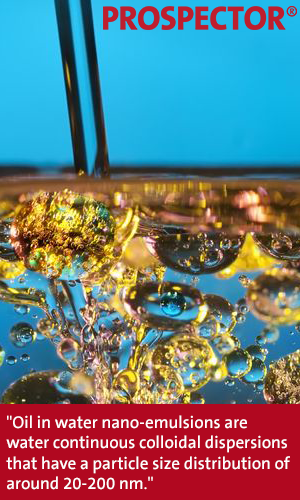Typically characterized by their clear or  bluish/translucent appearance, oil in water nano-emulsions are water continuous colloidal dispersions that have a particle size distribution of around 20-200 nm. These nano-emulsions are very stable to creaming due to Brownian motion.
bluish/translucent appearance, oil in water nano-emulsions are water continuous colloidal dispersions that have a particle size distribution of around 20-200 nm. These nano-emulsions are very stable to creaming due to Brownian motion.
Nano-emulsions can be formed by using either low or high energy processes. The phase inversion temperature (PIT) method is a low-energy process based on the changes in solubility of polyoxyethylene (EU) type of nonionic surfactants with temperature. These surfactants become lipophilic with increasing temperature because of dehydration of the polyoxyethylene chains. PIT emulsification takes advantage of the extremely low interfacial tensions achieved at inversion temperature. Above this temperature, a water in oil emulsion is formed which becomes a bicontinuous emulsion at the inversion temperature and an oil in water nano-emulsion below.
D phase emulsification is a low-energy process to make nano-emulsions that involves mixing a surfactant with a polyol (EU) or with a polyol and a small amount of water. Oil is then added and a gel is typically formed (oil in polyol-water emulsion). When additional water is added, an oil in water nano-emulsion is formed. Heating both phases prior to mixing helps promote a smaller particle size due to a lowering of the interfacial tension. The likely mechanism is the formation before dilution of a lamellar liquid crystalline phase.
High-energy approaches use equipment capable of generating intense disruptive forces to break up the oil phases. The most widely used include high-pressure valve homogenizers, micro-fluidizers, and sonication methods. Generally, conventional high-pressure homogenizers work in a range of pressures between 50 and 100 MPa.
Applications
- Stable thin emulsions for sprays or wipes
- Improved active skin penetration
- Improved deposition of emollients in rinse off products
Commercial technologies
- Nanocream (15%-Potassium Lauroyl Wheat Amino Acids, 25%-Palm Glycerides, 20%-Capryloyl Glycine, 40%-Water-Sinerga)
o Using 10% different oils and 5% Nanocream emulsions with a particle size of 120-320nm were produced.
o Using 10% Coco Caprylate/Caprate and 2.5-10% Nanocream the particle size ranged between 120-250nm.
o Cold mix 5% Nanocream and 10% oil and heat to 40-45C. Start heating until the mixture forms a homogeneous clear phase. Heat 25-30% (w/w) of water to the same temperature. Slowly add small increments of water phase to the mixture until a viscous gel is obtained. The formation of bluish color is typical of the nano particle size droplets and must be obtained in this step. Mix at least for 5 minutes again. Add the remaining water phase and continue stirring for 5-6 minutes. - Sucrose C1215L (Sucrose Laurate-Mitsubishi-Kagaku Foods)
o 20% C1215L is dissolved using 30% glycerin and heated to 75C. 50% oil is heated to 75C and is slowly added to the glycerin/surfactant. A nano emulsion will form on water dilution. - Tego Wipe DE PF (EU) (Diethylhexyl Carbonate; Polyglyceryl-4 Laurate; Phenoxyethanol, Dilauryl Citrate-Evonik (EU))
o Forms a nano-emulsion when diluted with water. - Expired patent US 5362418 (Kao-11/8/94) claims a gel-like oil in water concentrated emulsion can be prepared by adding an oil to a mixture of a monoalkyl phosphate salt, polyhydric alcohol and water. Very fine oil in water emulsions can be formed with very little surfactant and without high shear by diluting the gel (50nm particle size-3 to1 ratio oil to surfactant, 265 nm-350 to 1 ratio) with water. The lead surfactant was a high mono myristyl phosphate neutralized using arginine dissolved in glycerin/water. This is a very useful technology for making nano emulsions. High mono alkyl phosphates are commercially available.
The views, opinions and technical analyses presented here are those of the author or advertiser, and are not necessarily those of ULProspector.com or UL Solutions. The appearance of this content in the UL Prospector Knowledge Center does not constitute an endorsement by UL Solutions or its affiliates.
All content is subject to copyright and may not be reproduced without prior authorization from UL Solutions or the content author.
The content has been made available for informational and educational purposes only. While the editors of this site may verify the accuracy of its content from time to time, we assume no responsibility for errors made by the author, editorial staff or any other contributor.
UL Solutions does not make any representations or warranties with respect to the accuracy, applicability, fitness or completeness of the content. UL Solutions does not warrant the performance, effectiveness or applicability of sites listed or linked to in any content.



Leave a Reply or Comment